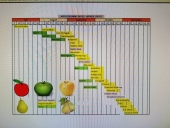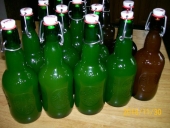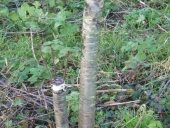
 14
14




A build too cool to miss:Mike's GreenhouseA great example:Joseph's Garden
All the soil info you'll ever need:
Redhawk's excellent soil-building series





 5
5








Striving to grow things as naturally, simply, and cheaply as possible! 
My YouTube channel
 13
13




Moderator, Treatment Free Beekeepers group on Facebook.
https://www.facebook.com/groups/treatmentfreebeekeepers/





 6
6




 10
10




 7
7




 3
3




A piece of land is worth as much as the person farming it.
-Le Livre du Colon, 1902
 3
3




When you reach your lowest point, you are open to the greatest change.
-Avatar Aang
 4
4




Steve Thorn wrote:
I'm going to try to air layer mine, and see how it works.
I'm really interested to try growing some varieties on their own roots too, which seems to offer a lot of neat benefits, and it also saves time and avoids having to graft!
Michael Cox wrote:
Your limiting factor is the ability to take cutting to create root stocks. This is not done commercially because apple cuttings have low success rate, and the alternative. Is super easy and reliable.
Typically they take a tree and cut it down to ground level. The tree will tend to sprout dozens on new shoots from the old stem. After cutting it down mound it up with damp sawdust to around 12 inches deep. A plastic bucket with the bottom cut out works well. Come back in the winter and the new growth will be around 2ft high (or more) and each will have extensively rooted into the sawdust. Just brush the sawdust aside and snip the main stems down nice and low.
R. Steele wrote:
Will the rootstock be of the size you want, and are those established rootstocks truly resistant to the diseases that can be prevalent in your area? Do you want full size trees? If I recall correctly you have experienced winters that have dropped to -40 F. Those harsh winters won't leave you many options for for varieties, if your selecting for varieties that can withstand the extreem end of known minimum temperatures in your area. I say this because healthy established trees are more hardy then trees you're trying to establish, so it may be wise to error on the side of caution. Less tolorant varieties known to do fine in zone 4b, may be best kept in a greenhouse over winter, or protected somehow untill they get established for a few years after grafting. …
Scott Foster wrote:
I say try it. Another good way to do it is to create small beds and do mass apple seed plantings.
I'm a really big fan of Skillcult. This guy is super knowledgable and he's doing it.
I'm personally using Kazakhstan apple seeds and it's variants, like the Liberty apple. These apples are resistant to CAR which I have pretty bad. I would not take cuttings from most common apples because they get decimated. I'm going for genetic diversity. I know the apples won't be the same as the parent.
William Bronson wrote:
Air layering is a similar process to the one Michael describes, but it involves wounding a living branch then wrapping the wound in a moist medium.
often the medium is peat moss and willow water or a rooting hormone is added.
A build too cool to miss:Mike's GreenhouseA great example:Joseph's Garden
All the soil info you'll ever need:
Redhawk's excellent soil-building series





 3
3




Timothy Markus wrote:Trace, is the tree grafted onto root stock? Where on the tree are you going to take cuttings from?
A build too cool to miss:Mike's GreenhouseA great example:Joseph's Garden
All the soil info you'll ever need:
Redhawk's excellent soil-building series





 3
3




James Landreth wrote:I think it's a good idea. I'd also grow a bunch of seedlings too and graft onto those. Cuttings can be tricky (at least for me) so doing both will guarantee a bunch of them
A build too cool to miss:Mike's GreenhouseA great example:Joseph's Garden
All the soil info you'll ever need:
Redhawk's excellent soil-building series





 2
2




When you reach your lowest point, you are open to the greatest change.
-Avatar Aang
 2
2




James Landreth wrote:Where will you be planting the trees? Are you giving them out or selling them or something?
A build too cool to miss:Mike's GreenhouseA great example:Joseph's Garden
All the soil info you'll ever need:
Redhawk's excellent soil-building series





 4
4




I make a Maple Syrup instructional movie! Check it out HERE
SKIP books, get 'em while they're hot!!! Skills to Inherit Property
See me in a movie building a massive wood staircase:Low Tech Lab Movie
 2
2




Mike Jay wrote:I tried rooting cuttings from known root stock (left overs from grafting). All 22 leafed out but didn't root out. I tried air layering with rooting hormone on three root stock suckers on a mature apple and none took.
I think either stool layering the trees you're going to cut or planting a thousand seeds from the apples of those trees would be the best way. Then graft the desired cultivars onto the ones that make it.
I agree with the larger trees handling the cold better. At least anecdotally based on what older homesteaders tell me.
A build too cool to miss:Mike's GreenhouseA great example:Joseph's Garden
All the soil info you'll ever need:
Redhawk's excellent soil-building series





 2
2




I make a Maple Syrup instructional movie! Check it out HERE
SKIP books, get 'em while they're hot!!! Skills to Inherit Property
See me in a movie building a massive wood staircase:Low Tech Lab Movie
 2
2




Mike Jay wrote:Apple cutting propagation may work, I just wouldn't bank on it working 100%. It could just be that under ideal situations, apple cutting have a 10% success rate. Maybe I missed a detail and that's why I got 0/22. Do you know if your existing trees are grafted or seed grown? If grafted, cuttings won't have the same disease resistance or root health that the parent plant has.
A build too cool to miss:Mike's GreenhouseA great example:Joseph's Garden
All the soil info you'll ever need:
Redhawk's excellent soil-building series





 4
4




 6
6




A build too cool to miss:Mike's GreenhouseA great example:Joseph's Garden
All the soil info you'll ever need:
Redhawk's excellent soil-building series





 6
6




Trace Oswald wrote:R., that's very generous of you. I'm not at all opposed to semi- dwarf trees, I've just read and been told they they aren't as strong. I'm certainly willing to try it. I'm not a commercial grower and have no intention of becoming one. I just want to feed my family and friends good healthy food, and I love the idea of the food forest with its initial work up front and many years of benefits.
My father planted blueberries, a lot of them, for his mother when he was 15 years old. He is 70 now and has never once fertilized, watered, pruned, or maintained those blueberries in any way. They are a jungle now, and everyone in the family has been eating all the blueberries they want every year, with more left over than we want to freeze. 55 years he has been harvesting from one day of planting. That's my goal. My young food forest area is approximately 2 acres, and I have at least 8 more acres i can convert if i run out of room. I have lots of room for testing things.
When you reach your lowest point, you are open to the greatest change.
-Avatar Aang
 5
5




 4
4




Moderator, Treatment Free Beekeepers group on Facebook.
https://www.facebook.com/groups/treatmentfreebeekeepers/





 5
5




 7
7






 5
5




A build too cool to miss:Mike's GreenhouseA great example:Joseph's Garden
All the soil info you'll ever need:
Redhawk's excellent soil-building series





 5
5




 6
6




When you reach your lowest point, you are open to the greatest change.
-Avatar Aang
 2
2




John Wolfram wrote:Given enough time, I think your plan of taking cuttings, rooting them, and then grafting would work. However, it would take a long time to get an orchard full of apples. By spending $100 on root stock, you could probably cut two years off the timeline since. Spending another $200 to get already grafted mail order trees could shave another two years off the timeline. I'm a cheap SOP, but since I figured I'd easily get more than $75 a year worth of fruit out of my trees the choice was easy (not even factoring the amount of work I saved by not having to protect the young trees for an extra four years).
James Landreth wrote:My cherry and plum trees drop tons of seedlings in my yard. I've been potting them up as rootstock for some of the food forests I'm involved in. They'll be standards but at least they're free. And standard cherries are great timber as well as food for birds and bees
A build too cool to miss:Mike's GreenhouseA great example:Joseph's Garden
All the soil info you'll ever need:
Redhawk's excellent soil-building series









 1
1








 4
4




 1
1




 1
1




 4
4




 2
2








 1
1





|
Scaramouche. Scaramouche. A tiny ad dressed as a clown.
The new gardening playing cards kickstarter is now live!
https://www.kickstarter.com/projects/paulwheaton/garden-cards
|







